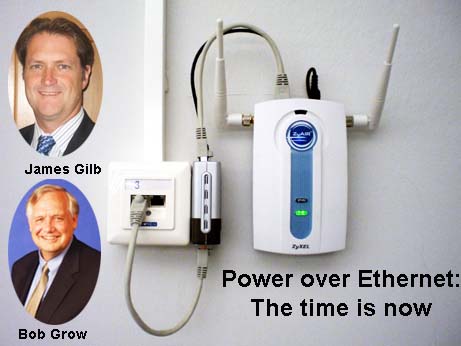
Image: a ZyXEL ZyAIR G-1000 Acces Point, powered by a D-Link DWL-P50 PoE-Splitter ( Wikedia Commons)
We return to the subject of Power over Ethernet -- a technology, we believe is poised for significant levels of deployment. PoE technology describes a system to safely transfer electrical power, along with data, to remote devices over standard data cables in an Ethernet network (Cat3/Cat5/Cat5e/Cat6 ). The original IEEE 802.3af-2003 standard version of PoE supplies up to 15.4 W of DC power (minimum 44 VDC and 350 mA) to each device. The latest version - 802.3at-- mandates higher power PD’s such as wireless access points, panning security cameras, video phones, and audio appliances requiring continuous power to 25.5 watts up to 100M from the Power Sourcing Equipment http://www.ieee802.org/3/at/
By James Gilb and Bob Grow, IEEE
Today,Ethernet’s role in data networking for the power grid makes it worthy of celebration, as its role is assured, its future is bright and its history is
long.
Forty years have passed since Ethernet was conceived and today it remains the lingua franca for mixing and matching all data network protocols used in many aspects of the power grid. Further, given its performance, Ethernet provides an inexpensive, cost-effective solution, and it is a well-understood and accepted technology.
Today Ethernet is used throughout the power grid, and as legacy equipment is upgraded to include wired data communications, Ethernet is likely to be used. It bodes well for the future that Ethernet’s physical components are produced by a rich set of vendors, making it cost effective to implement and manage. Ethernet’s success, in turn, underscores how methodical, consistent efforts by the Ethernet Working Group of the IEEE Standards Association to foster interoperability have paid dividends. The original Ethernet standard – IEEE 802.3™ – was approved in 1983 and over the past 30 years, many refinements have been made while maintaining backwards compatibility.
Let’s attempt to define “Ethernet” in a smart grid context. Ethernet is a family of data network technologies that takes different forms, depending on its application or capabilities. The most widely used wired transmission technologies are defined in IEEE 802.3, though other standards extend Ethernet’s capabilities. Other technologies in the IEEE 802 standards family, such as Wi-Fi (IEEE 802.11™), Zigbee and WiSun (IEEE 802.15.4), WiMAX (IEEE 802.16) and WiFAR (IEEE 802.22), maintain compatibility with Ethernet while offering wireless connectivity.
The reliability of data transport is critical to smart grid and the low error rates inherent in the IEEE 802.3 physical technologies make it rare that data over an Ethernet becomes corrupted. But Ethernet also has an effective error detection algorithm that prevents delivery of corrupted data.
Further, Ethernet, as with other IEEE 802 networking technologies, offers a means to run multiple protocols over the same network, while allowing them to coexist as discreet streams of information. That’s valuable because you can mix and match protocols, send them over the same wire and still parse them correctly at the other end. That means that one set of wires (often a “twisted pair,” in Ethernet parlance) or a fiber optic cable can carry segregated traffic between various systems and yet maintain separation and security among them.
Ethernet’s bandwidth management capabilities enable more predictable delivery of data for one protocol over another. SCADA data, for instance, can be assigned a higher priority over simple billing data. That means, for instance, that control and protection equipment signals can propagate across the network in milliseconds, while less critical data receives lower priority.
Ethernet also offers functional flexibility in various applications. For instance, in the case of advanced metering infrastructure, wireless Ethernet is useful for collecting data from myriad endpoints, which then is aggregated and backhauled using wired Ethernet. On a physical level, in environments such as a substation, ruggedized Ethernet products have been developed to meet the practical demands of the grid.
And the future? Increases in data rates are expected for Ethernet, based on drivers for other industries, such as the bandwidth required by the massive Internet data centers that connect thousands of individual servers. The evolution of Ethernet will also be driven by automotive and industrial applications that will benefit the grid.
The upshot for the power system is that virtually all grid data, with the exception of some legacy equipment, will continue to travel over Ethernet on some path within the smart grid network, and that will remain true for years to come.
About the Authors Dr. James P. K. Gilb has 18 years’ experience in radar absorbing materials, RFIC and radio systems design and MAC protocols. He is currently the IEEE802 LMSC Executive Committee Second Vice Chair, Technical Editor o fIEEE 802.15™ WG and Technical Editor of the IEEE 802 Architecture and Overview standard. He has six issued patents, written many papers in refereed journals, and is the author of two books. He is the director of product development and technical marketing at Tensorcom, which he joined in 2011.
Robert (Bob) Grow started his career as a systems architect in the mid-1970s, working on converged communications, with emphasis on local area networks. That emphasis has continued throughout his career working on the application of LANs in a broad range of products, systems and environments. He led the Information Technology Task Force for IEEE2030 on Smart Grid Interoperability. He has participated in various working groups in IEEE 802 since 1981, is a former Chair of IEEE 802.3 and a past Chair of the IEEE-SA Standards Board. He is a co-founder of three start-up companies. Bob is an IEEE fellow and currently works as an independent consultant.
Sep 29 2013